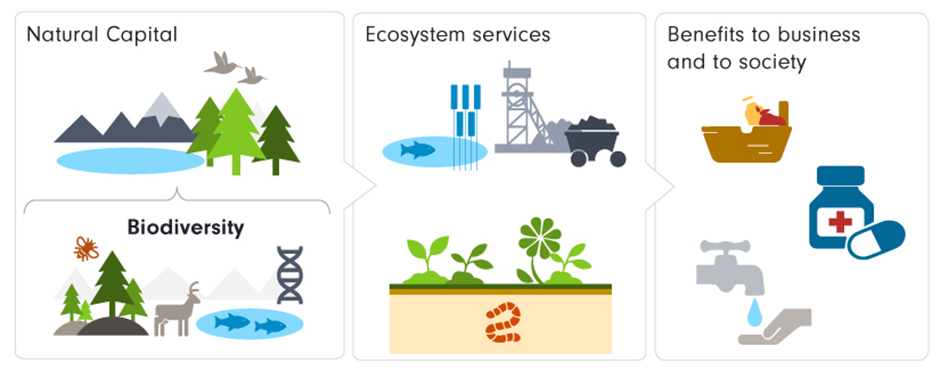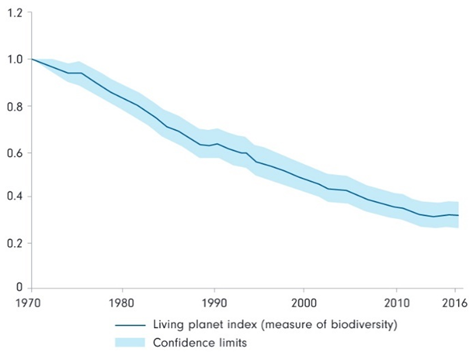Biodiversity is the Earth’s balance of plant and animal species, ranging from the largest, like the blue whale, down to the smallest virus. Biodiversity’s ‘ecosystem services’ help support food production, water purity, and raw materials. They also regulate climate patterns, contribute to blocking pollution and inspire medicines.
In short, we rely on biodiversity for our very survival.
While biodiversity relates to the variety of species, natural capital is the total stock of renewable and non-renewable natural resources. Natural capital acts as a framework for understanding the multiple benefits and relationships between nature, people, the economy, and society.
Biodiversity is the variety of living natural capital and the diversity in ecosystems
Source: Fidelity International, July 2022.
Top Australian Brokers
- Pepperstone - Trading education - Read our review
- IC Markets - Experienced and highly regulated - Read our review
- eToro - Social and copy trading platform - Read our review
Life on our planet is the result of billions of years of evolution. Yet, despite this extended span, it is probably more fragile than we think. More than any other species, humans have negatively affected the Earth’s biodiversity. This is considered to be due to a persistent drive to alter our environment, such as turning forests into arable land or deserts into cities. A process that accelerated in the second half of the 20th century, with a substantial decline recorded since 19701.
How wildlife has declined, 1970-2016
Source: ZSL
The most recent study2, published in 2019 by the United Nations Environment Programme (UNEP), warned that biodiversity has continued to deteriorate, and greater progress is needed if the pace of loss is to slow.
Indeed, a loss of nature across the Asia Pacific region is expected to profoundly damage economic activities that rely on natural capital, with as much as 63per cent (US$19 trillion) of Asia Pacific’s GDP at risk3 – a higher share than the global average.
Four principal causes of biodiversity decline
Climate change affects biodiversity by disrupting the efficient functioning of the Earth’s ecosystem with rising temperatures and changing weather patterns. An excellent example of this linkage is how warmer oceans negatively affect both coral reefs and the amount of sea ice in the Arctic. This leads to a reduction in biodiversity across both areas.
Another major cause of decline is habitat loss caused by human activities – for example, burning vegetation or animal clearance to grow crops or develop infrastructure.
Pollution is also a significant contributor and can make land and sea areas uninhabitable for fish, animals, plants, and other life. While the level of contamination in more advanced territories has reduced in recent years, many less developed markets continue to pollute their environment, primarily due to less stringent regulations or a lack of enforcement and measurement. Less obvious forms of pollution like noise and light can also have a bearing on biodiversity by disrupting animal reproductive success.
Humans can harvest resources faster than they regenerate, resulting in potentially permanent biodiversity loss. The destruction of sustainable marine stocks due to overfishing is an example of overexploitation.
The direct benefits of biodiversity
Many people enjoy spending time outdoors, with the benefits4 of fresh air and interacting with nature widely acknowledged. Indeed, nature tourism is prevalent worldwide and can deliver significant economic and cultural advantages, especially among developing nations that depend on tourism dollars. The sustainability of specific industries like hunting and recreational fishing depend on careful environmental management and stakeholder agreements to preserve global resources.
The cost of losing biodiversity
The Economist Intelligence Unit found that humans have been responsible for destroying 50 per cent of plant life and over 80 per cent of known animals. The European Union’s (EU) Biodiversity strategy for 2030 report (May 2020) estimated that the world lost between €3.5-18.5 trillion annually in ecosystem services from 1997 to 2011 due to land-cover change and degradation caused by climate change and unsustainable farming practices.
Rich biodiversity can protect humans from disease transmission by acting as a buffer zone. For instance, the World Health Organisation (WHO) reported that areas with higher bird diversity showed lower rates of West Nile virus infections because mosquitos, as a vector of infection, were less likely to find suitable hosts5. Biodiversity loss can also drive wildlife closer to humans, increasing the risk of disease outbreaks.
Putting this in a medical context, one third of the medicines used today come from nature, including 70 per cent of cancer drugs, and genetic variation is vital for our treatments. Aspirin, for example, is made from the bark of willow trees – without nature, this medicine would not have been developed. However, if certain species with yet-to-be-identified benefits disappear, so do the potential benefits for healthcare. With fewer discoverable treatments, the future financial burden of healthcare costs is likely to be higher than it would be with richer biodiversity.
A lack of biodiversity can also impinge on food production. Some crops depend on insects as pollinators; without them, yields could fall or disappear altogether. Pollinating insects can be affected by environmental changes or our propensity for pest control, which has a spill over effect on beneficial species. Furthermore, pests can become more difficult to control if humans remove their natural predators. Lower food production also causes prices to rise, which adds to cost-of-living, particularly among those who spend a more significant proportion of their income on food.
Making sustainable investment decisions
Pinpointed as the United Nation’s Sustainable Development Goals (SDGs) – with preservation of life below water and life on land, investors and consumers are starting to recognise the value of biodiversity, providing meaningful drivers to its investment growth. The financial industry is beginning to reassess the value of potentially vulnerable or stranded assets. In turn, it has either trimmed their valuations or, in some cases, viewed them as potential liabilities. For household names particularly, avoiding biodiversity issues could harm their reputations.
Meanwhile, adopting solutions that help reduce biodiversity loss is likely to be supported by policy tools, increasing business costs. Disintermediation and risking compliance costs are material potential risks to business models globally and, therefore, to investor portfolios.
We believe that any environmental, social, and corporate governance (ESG) risks related to biodiversity loss will become central factors in the investment decision-making process. Investing in businesses that hedge biodiversity-related risks, including more sustainable agricultural methods or renewably powered transportation, helps preserve biodiversity by channelling capital towards the right solutions. A good example of a potential solution is the development of biologically friendly pesticides, which could be crucial to combat biodiversity loss. Some mutual fund investors indirectly address this risk through specific fund exclusion policies on palm oil and deforestation.
Fidelity International is committed to reducing biodiversity loss, and we actively engage with investee businesses to encourage them to improve their ESG profiles. We help management teams understand how their business operations affect the planet and engage on ways to minimise their impact.
As businesses engage with sustainability-minded investors, their management teams are more likely to recognise the financial and environmental advantages of supporting a healthy ecosystem.
Originally published by Fidelity International investment experts.







